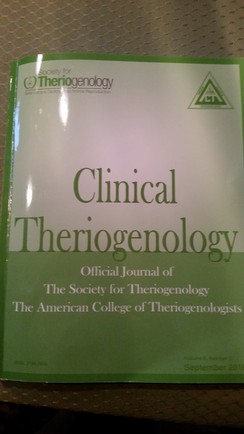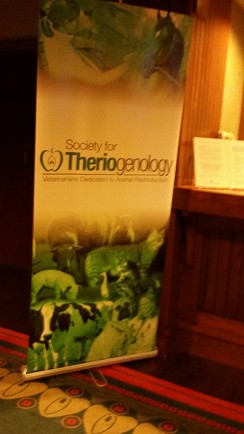|
July 19, 2024
Do Differences in Maternal Immunoglobulin G Influence Passive Transfer and Subsequent Cria Growth in Alpacas?
Presented at the Theriogenology Veterinary Conference 2016
By: Kim Gleason, PhD , Lynn Edens Arturo Pena

There's our Issue! Our paper is on page 300

Conference Hotel-Ashville, NC

Checking in to the conference

Finally on stage!

We are very proud to announce that the first part of our year-long research study has been accepted for publication in the prestigious scientific veterinary journal, Theriogenology. I was thrilled to have our work recognized by the scientific community & given the opportunity to present our findings at the Theriogenology annual meeting in July. This important study was overwhelmingly received positively by veterinarians from all over the country:
Do Differences In Maternal Immunoglobulin G Influence Passive Transfer and
Subsequent Cria Growth in Alpacas?
Kim Gleason, PhD1, Lynn Edens2, Arturo Pena2
1 Dancing Horse Farm, Pemberton, NJ 08068, 2 Little Creek Farm, North Salem, NY 10560
Undetected failure of passive transfer (FPT) of immunoglobulin is a major determinant of mortality in newborn alpaca cria, and early detection with proactive management can reduce mortality rates in cases of suspect FPT. The goal of this prospective observational study was to evaluate maternal serum IgG levels as a predictor for subsequent cria FPT (IgG <400 mg/dl) and/or poor cria early development. Prepartum blood samples were collected on dams within 60 days of anticipated birth, and on suckling cria within 36 hours after birth, and analyzed for serum IgG concentration by use of a commercial spectrophotomic assay. Any cria with a birth IgG < 400 mg/dl was offered oral maternal colostrum as routine practice. Birth weights, and weights at two weeks and two months were recorded for all cria to establish growth patterns. Dams were divided into three groups based on natural breaks in prepartum IgG levels of 1000 to 1499 mg/dl (n = 25), 1500 to 2000 mg/dl (n = 22), and >2000 mg/dl (n = 13). Analysis of variance within maternal groups revealed significant differences in cria birth IgG levels, whereby the highest levels were observed when dam IgG measured 1000-1499 mg/dl, followed by 1500-2000 mg/dl and cria had the lowest birth IgG levels from dams exhibiting IgG levels > 2000 mg/dl (640 mg/dl, 554 mg/dl and 545 mg/dl respectively). Although there were cria with birth IgG <400 mg/dl in every dam group, there were more in the latter group. Cria that were handfed maternal colostrum tended to have lower measured IgG, but this did not reach statistical significance. Despite differences in birth IgG levels, cria birth weights, weights at two weeks and weights at two months did not differ amongst maternal groups. Interestingly, the maternal group with the highest IgG and subsequent lowest cria IgG levels had more births in the spring than the other groups, raising concerns for a seasonal effect on immunoglobulin passive transfer. Results of this study suggest that maternal IgG could be an early, gestational indicator of potential FPT births in North American alpacas. Early identification of possible problems can negate the need for costly and invasive treatments such as plasma transfer, which often requires hospitalization. More research is needed to follow cria development to weaning, and to investigate possible seasonal influences on passive transfer.
|